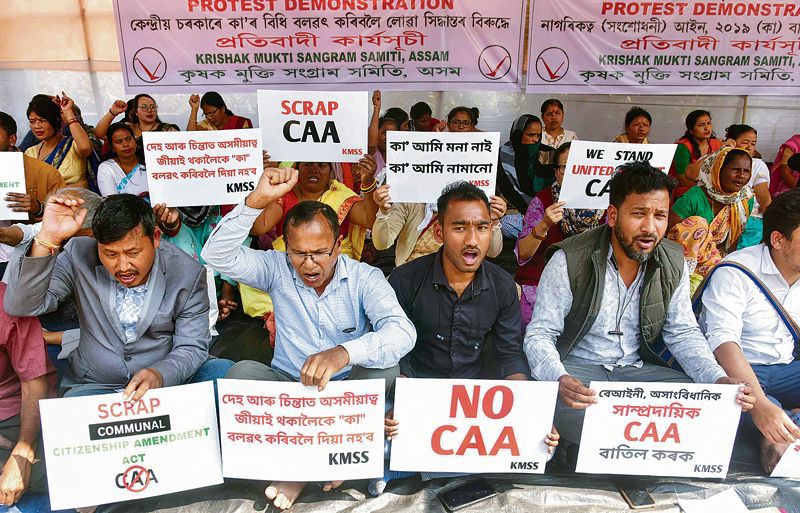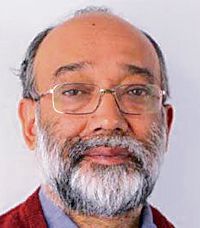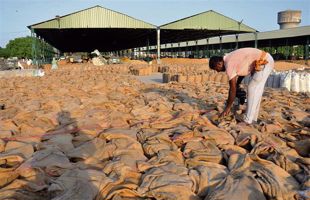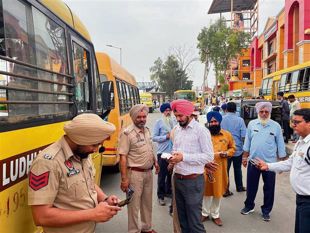
Ticking bomb: Although anti-CAA protests are taking place in Assam, West Bengal, Kerala and other parts of the country, these appear sporadic and muted compared to the storm that swept across India in 2019-20. However, the objections may escalate in the coming weeks. ANI
Sanjoy Hazarika
Author and Columnist
The Tribune Debate Citizenship amendment act
THE Centre has announced a 39-page set of rules that gives muscle and teeth to the Citizenship Amendment Act (CAA), 2019. Coming as it does a few weeks before the Lok Sabha elections, the development has stirred controversy, with Opposition leaders accusing the ruling dispensation at the Centre of seeking to polarise the electorate.
The Bharatiya Janata Party says it has fulfilled another electoral promise and notes that fears about the CAA being used to deprive people of citizenship are just unfounded apprehensions.
The core aim of the Act is to provide citizenship to those from six religions — minorities in Afghanistan, Pakistan and Bangladesh — who have fled persecution and settled illegally or informally in India. These six religious groups are Hindus, Christians, Buddhists, Sikhs, Parsis and Jains from those countries. Muslims are excluded. The rationale for the latter’s exclusion is that those three are Islamic countries with overwhelming Muslim majority, essentially indicating that they should be able to get justice within their nations. It does not take into account the issue of prejudice.
New Delhi has retained control over the process by creating committees staffed by Central officials to oversee the applications. Under the old procedure, district authorities were mandated to receive the requests. The CAA reduces the waiting period of the application for citizenship, a Central Government mandate, from 11 to five years, but applicants need to present official documents from their homeland.
Although anti-CAA protests are taking place in Assam, West Bengal, Kerala and other parts of the country, these appear sporadic and muted compared to the storm that swept across India in 2019-20, resulting in numerous deaths and widespread arrests. However, the objections may escalate in the coming weeks.
Despite the demonstrations, there is a larger issue at stake — the Supreme Court is yet to hear and rule on a slew of legal challenges to the CAA, essentially contesting its constitutionality. The key argument has been that by instituting religion as a marker of citizenship, the CAA violates the basic premises of the Constitution, which prohibits religious discrimination and guarantees all people equality before the law and equal protection of the law.
The initial challenge to the law was mounted in 2020, but the apex court is yet to hear these objections, although a five-judge Constitution Bench led by the Chief Justice had, in December last year, reserved its verdict in another case concerning pleas challenging the validity of Section 6A of the Citizenship Act, 1955. This specific amendment dates back to the Assam Accord of 1985, which sought to bring stability to the state after six years of turmoil over the perennial challenge of alleged irregular migration from Bangladesh. It provided a mechanism to recognise people who came illegally as Indian citizens after registering them for citizenship. March 25, 1971, was fixed as the cut-off date for granting citizenship to Bangladeshi migrants in Assam.
There are points, often overlooked, that reinforce the complexities of the core issues. First, the situation in Assam was complicated by the rollout of the National Register of Citizens (NRC) in 2019, for which 1.9 million applicants did not make the cut. A majority of this number were Hindus and members of indigenous communities, not Muslims, which took the BJP and its allies by surprise. They have since been demanding a revision. Yet, nearly five years down the line, those off the NRC list have not been able to file objections and seek their reinstatement under the law. In addition, a large number of people have had their Aadhaar cards frozen, and the state government is making special facilities to enable them to access basic services available under national and state schemes. Activists against irregular migration into Assam also opposed the CAA, arguing that religion should not determine citizenship.
Second, the list of communities that are to receive succour appears incomplete. It does not include groups like the Sri Lankan Tamil Hindus and Christians, over 90,000 of whom are refugees in this country, or the Chin Christians from Myanmar (over 45,000 are in Mizoram alone).
Belonging to one religion does not reduce the risk of persecution for minority groups, even within that religion. But the CAA did not find the need to provide protection for vulnerable Muslim groups, such as the Ahmadiyyas in Pakistan and the Hazaras in Afghanistan. The Centre has taken sporadic action against the Rohingyas of Myanmar, much to the concern of UN agencies, which see this group as among the most persecuted communities in the world.
The CAA will not be applied across India uniformly. It will not be implemented in parts of the North East: the states of Arunachal Pradesh, Nagaland, Manipur, Meghalaya and Mizoram and three tribal-dominated areas of Assam (with small populations) and Tripura, which have special constitutional protection. In geographical terms, this means that almost half of the region is excluded from the CAA’s purview, although in terms of population, it is much less, considering Assam’s numbers.
Yet, given the purposed scale of the citizenship issue, few hard facts have been provided about the number of illegal migrants living in India. The Ministry of Home Affairs declared in an affidavit to the Supreme Court last December, without giving numbers, that “illegal migrants enter the country without valid travel documents. The detection, detention and deportation of such illegally staying foreign nationals involve a complex ongoing process.”
While it is important to continue to be vigilant and press for constitutional approaches to the CAA and the NRC, there are other priorities and concerns that demand our attention.
In the distant, quiet Mizoram, where the CAA will not prevail, there is greater anxiety about another issue — the proclaimed building of a fence along the 1,643-km-long Indo-Myanmar border and the repeal of the Free Movement Regime that will divide communities from each other, another way of restricting citizens and travel. These are also national security challenges that need to be addressed. The fact that they are not in the mainstream media or spoken of by governments doesn’t mean that the issues can be ducked.
Join Whatsapp Channel of The Tribune for latest updates.




























